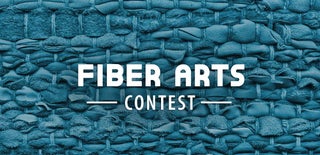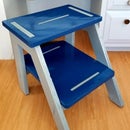Introduction: RoosterCube: Cube-Shaped Stuffed Animals!
Introduction:
So right now I was expecting to have a few more weeks in college and way more time to use the sewing machines and other tools in our well-equipped campus makerspace. Instead, I find myself locked in my house, across the country, waiting out a deadly pathogen bent on destroying the world (COVID-19). Naturally this is a perfect time to follow through on a few instructables! This is my first instructable, so I thought I would get my feet wet with a project I had designed from scratch; something I could truly call my own: the RoosterCube. While the first design was a rooster, I have some examples of other cube-shaped stuffed toys.
As I am sure you will gather through this instructable, I am using only things I could find in my house and while they are not the ideal tools for the job, they get the job done. The cool part is that you don't need a sewing machine or anything complex to do this. The entire project can be completed by hand with rather accessible tools. Welcome to Day 2 of the quarantine.
So with that, lets dive right in!
Supplies
What you need:
- · Cloth – lots of it
- · Scissors
- · Needle
- · Thread
- · Buttons
Since I do not have a sewing machine anymore, which would make this process infinitely faster, I will be sticking to good old-fashioned needle and thread. I recommend wrapping your off-hand thumb or using a thimble to protect it from impalement.
I also do not have access to good fabric scissors, so I will be using a trusty pair of regular scissors. Fabric scissors cut cloth in a jagged pattern called a bias so that the fabric does not fray apart. I will have to take extra precaution not to let the fabric fray when I sew it.
The last thing I will need are two buttons: these will be the eyes of the rooster. I picked colors that contrasted the dark blue of the body.
Step 1: Cut Out the Net
I probably shouldn’t use too much of this fabric though in case we need to use them for making torches or tents in the impending apocalypse.
That’s why I cut out 6 six-inch squares to make the sides of the cubes, one kite shaped net for the beak, and 3 rounded kite shapes for the wings and comb (the frill on top of a rooster’s head).
This work looks messy and a bit haphazard, but that’s okay. We will make it beautiful when we sew it. Just make sure whatever size you want the rooster to be, you add half an inch to each dimension. For example, if I want a rooster that’s 5”x5”x5”, I will cut out, six-inch squares.
We do this because we will be folding in the edges later.
Likewise, make the beak, wings, and comb nets larger than you intend.
Step 2: Sew the Edges of Beaks and Wings
So, because we didn’t use fabric scissors, we need to combat the edges from fraying using whatever method we can. I am deciding to fold over the edges of the sides and using a straight stitch to add some rigidity and permanence to the edges of the beak. A straight stitch is the simplest stitch. If you had no idea what stitching is, and you’re asked to stitch something together, you would probably come up with the straight stitch. Straight stitch tutorial: https://www.youtube.com/watch?v=v5P8YrNjNKA.
It’s keeping the two pieced of fabric together, and you go back and forth through the fabric. If you have a side of your fabric that is the “good” side or the side you want displayed, make sure you fold that side onto the other side as shown in the images below. I finish my stitches by making passing the thread through a previous loop a couple times and pulling it tight.
The first image shows the decorative side down and folded on to the non-decorative side, which is on top. The other image shows the decorative side on top.
Step 3: Sew the Net of Six Squares
I used a straight stitch to sew the net of the cube as shown below.
I start about a half inch in from each side and stop half inch before the other side.
It’s important to note that you sew the peripheral squares all to the same side of the central square for consistency. Look at the associated images for reference. This is a pain to have to redo, so as always, measure twice, stitch once.
Step 4: Sew the Beak, Wings and Eyes on the Cubes
This is important to pay attention that you sew these onto the correct side. There is the inside of the cube, which has all the visible stitches and the outside of the cube where the stitches are hidden, and it looks like a seam.
I made this mistake embarrassingly 3 times, and its really annoying to cut your stitches and remove the thread, so instead of causing yourself that pain, just do it right the first time. The three images elaborate on this. The first image shows the final arrangement of wings. The second an third images show the inside of the cube and the outside of the cube respectively. When we finish sewing the cube, it will be inside out, and we will have to flip it inside out.
To lay this out a bit more concretely, let’s say the center of the net is the top of the bird, the two offshoots will have the wings and the short side will be the front face. Sew the wings to each side with a straight stitch. Sew the buttons to the front in roughly eyeball locations as shown. You sew the button on by following an x-pattern to hold it securely in place.
Sew the beak on using a straight stitch.
The comb sewn on top is fun. I folded the comb in half to give it some height and flayed the base out a bit and sewed it down to the top face of the bird. This gives it height and rigidity.
Just a note, the tighter your stitch density is, the stronger the bird will be held together. This seems obvious but remember this when you have been sewing for hours, poked your thumb 1000 times, and you really want to cut corners and finish quicker. You want to be patient and maintain a high stitch density as it will serve you well in the long run. Okay, that’s my cleverly veiled life advice inserted into my instructable.
Step 5: Sew the Remaining Sides, But Leave a 2 Inch Gap in the Last Side
This step is as simple, yet as tedious as it sounds.
Straight stitch along each edge of the cube except for the last side where you leave about 2 inches un-stitched, basically leaving a hole in the cube at that edge. Notice how it still looks really ugly? That's because we are going to flip it inside out.
Step 6: Turn the Cube Inside Out
I think a picture is worth a thousand words here. The three images show the before and after you flip the cube inside out and the hole you shove things through. One disclaimer is that it will still be hollow and floppy as the cube has not been stuffed yet, but the eyes, wings, beak, etc should be on the outside now.
You are basically pushing the correct side out through the small 2-inch unstitched part of the cube.
Step 7: Stuff It!
Using a material like polyfill or some stuffing of sorts, you can fill up the cube until the rooster takes shape. Stuff it though the unstitched 2-inch hole in the cube. Make sure you fill in enough that the cube shape holds on its own. Reach in through the unstitched side to poke out the corners of the cube and make sure they are filled in properly.
Because I do not have nice material like polyfill, I am just going to use a cut up old cloth. I used the remaining cloth from the wings, beak etc. That was enough to fill the cube. It's soft and loose and can provide enough rigidity in this trying time. I was going to stuff it with toilet paper and have the rooster be like a safe for the most valuable commodity during the quarantine, but in the end I decided against it because it would entail ripping apart my creation to “open the safe”.
Step 8: Sew Up the 2-inch Gap
This last side we are going to use the ladder stitch to finish it up. Since the seam is now on the outside, we can’t just use the straight stitch. A ladder stitch seems like the same thing as a straight stich, but how we do it is we only pass the thread through one side at a time, making sure that the edge of the fabric square never peeks out of the cube, making our design look ugly and unrefined. Here is a great tutorial for ladder stitch: https://www.youtube.com/watch?v=K3fFHV6r9Ow. As is explained in this video the other reason we use this stitch is because its virtually undetectable on the outside if done correctly. You can see in the image mine is solidly okay.
Step 9: Final Thoughts
Here are some other renditions of the cube stuffed animal. The one I created purely by hand is, admittedly, not my best work. The other ones are made using a sewing machine and the same process. I also had access to nicer cloths for the other two animals. I thought I would throw in a cool video of one of the animals that I turned into a lamp. I call him Cubo. I hope you enjoyed this cute project, hopefully it can help you stay busy while hunkered down, or if you are reading this after the plague has ended, hopefully its just a fun project with a fun result!

Participated in the
Fiber Arts Contest











